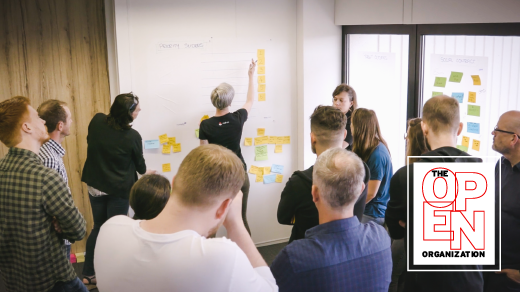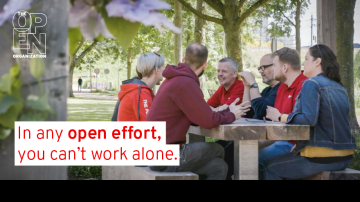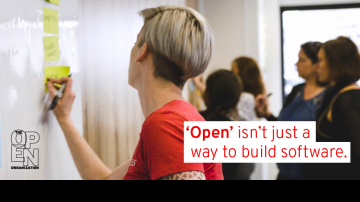Activists really don't like feeling stuck.
We thrive on forward momentum and the energy it creates. When that movement grinds to a halt, even for a moment, our ability to catalyze passion in others stalls too.
And my colleagues and I at Greenpeace International were feeling stuck.
We'd managed to launch a prototype of Planet 4, Greenpeace's new, open engagement platform for activists and communities. It's live in more than 38 countries (with many more sites). More than 1.75 million people are using it. We've topped more than 3.1 million pageviews.
To get here, we spent more than 650 hours in meetings, drank 1,478 litres of coffee, and fixed more than 300 bugs. But it fell short of our vision; it still wasn't the minimum lovable product we wanted and we didn't know how to move it forward.
We were stuck.
Planet 4's complexity was daunting. We didn't always have the right people to address the numerous challenges the project raised. We didn't know if we'd ever realize our vision. Yet a commitment to openness had gotten us here, and I knew a commitment to openness would get us through this, too.
As the story of Planet 4 continues, I'll explain how it did.
An opportunity
By 2016, my work helping Greenpeace International become a more open organization—which I described in the first part of this series—was beginning to bear fruit. We were holding regular community calls. We were releasing project updates frequently and publicly. We were networking with global stakeholders across the organization to define what Planet 4 needed to be. We were architecting the project with participation in mind.
Becoming open is an organic process. There's no standard "game plan" for implementing process and practices in an organization. Success depends on the people, the tools, the project, the very fabric of the culture you're working inside.
Inside Greenpeace, we were beginning to see that success.
For some, this open way of working was inspiring and engaging. For others it was terrifying. Some thought asking for everyone's input was ridiculous. Some thought only "experts" should be part of the conversations, a viewpoint that doesn't mesh well with the principle of inclusivity. I appreciate expertise—don't get me wrong—but the problem with only asking for "expert" opinions is that you exclude people who might have more interest, passion, and knowledge than someone with a formal title.
Planet 4 was a vision—not just of a new and open engagement platform, but of an organization that could make use of this platform. And it raised problems on both those fronts:
- Data and systems integration: As a network of 28 independent offices all over the world, Greenpeace has a complex technical landscape. While Greenpeace International provides system recommendations and support, individual National and Regional Offices are free to make their own systems choices, even if they aren't the supported ones. This is a good thing; different tools better address different needs for different offices. But it's challenging, too, because the absence of standardization means a lack of expertise in all those systems.
- Organizational culture and work styles: Planet 4 devoured many of Greenpeace's internal strategies and visions, then spit them out into a way that promised to move toward the type of organization we wanted to be. It was challenging the organizational status quo.
Our team was too small, our work too big, and the landscape of working in a global non-profit too complex. The team was struggling, and we needed help.
Then, in 2018, I saw an opportunity.
As an Open Organization Ambassador, I'd been to Red Hat Summit to speak on a panel about open organizational principles. There I noticed a session exploring what Red Hat had done to help UNICEF, another global non-profit, with its digital transformation efforts. Surely, I thought, Red Hat and Greenpeace could work together, too.
So I did something that shouldn't seem so revolutionary or audacious: I found the Red Hatter responsible for the company's collaboration with UNICEF, Alexandra Machado, and I said hello. I wasn't just introducing myself; I was approaching Alexandra on behalf of a global community of open-minded advocates.
And it worked.
Accelerating
Together, Alexandra and I spent more than a year coordinating a collaboration that could help Greenpeace move forward. Earlier this year, we started to succeed.
In late May, members of the Planet 4 project and a team from Red Hat's App Dev Center of Excellence met in Amsterdam. The goal: Accelerate us.
We'd spend an entire week together in a design sprint aimed at helping us chart a speedy path toward making our vision for the Planet 4 engagement platform a reality, beginning with navigating its technical complexity. And in the process, we'd lean heavily on the open way of working we'd learned to embrace.
At the sprint, our teams got to know each other. We dumped everything on the table. In a radically open and honest way, the Greenpeace team helped the Red Hat team from Waterford understand the technical and cultural hurdles we faced. We explained our organization and our tech stack, our vision and our dreams. Red Hatters noticed our passion and worked alongside us to explore possible technologies that could make our vision a reality.
Through a series of exercises—including a particularly helpful session of event storming—we confirmed that our dream was not only the right one to have but also fully realizable. We talked through the dynamics of the systems we are addressing, and, in the end, the Red Hat team helped us envision a prototype for integrated systems that the Greenpeace team could take forward. We've already begun user testing.
Listen to Patrick Carney of Red Hat Open Innovation Labs explain event storming.
On top of that, our new allies wrote a technical report that laid out the complexities we could see but not address—and in a way that spurred internal conversations forward. We found ourselves, a few weeks after the event, moving forward at speed.
Finally, we were unstuck.
In the final chapter of Planet 4's story, I'll explain what the experience taught us about the power of openness.








Comments are closed.